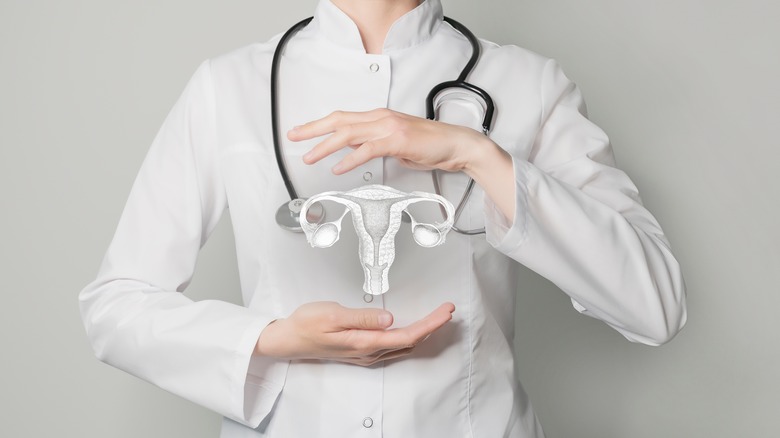The 4 Stages Of Uterine Cancer Explained
Uterine cancer is one of the most common types of cancer in women in the United States. The vast majority of uterine cancers begin in the lining of the uterus, which is known as the endometrium. These tumors are called endometrial cancers (via Cleveland Clinic). Some less common types of uterine cancer can develop in other parts of the uterus, such as the muscular walls (myometrium). These are called sarcomas.
In most cases, endometrial cancer is detected at an early stage, when it is still confined to the uterus. When caught early, the disease is highly treatable and has a good prognosis. However, if the cancer has spread to other parts of the body, it can be much more difficult to treat. Uterine cancer is typically divided into four stages to determine the severity of the disease. Each stage also classifies the tumor's size and location and if the tumor has spread to other parts of the body. Understanding these four stages can help you better understand your treatment options and prognosis.
Stage 1
According to Health, stage 1 uterine cancer means the cancer is confined to the uterus. The cancer may have spread to the endometrium, but not to the myometrium or beyond the uterus. The most common symptom of this stage is irregular vaginal bleeding, which can include irregular periods or spotting between periods. Postmenopausal women may also experience spotting or vaginal bleeding. Pain during sex is another symptom. Some women may experience no symptoms at all.
People who are diagnosed with stage 1 uterine cancer are typically treated through surgery. This may involve a hysterectomy, which is the removal of the uterus. The ovaries and fallopian tubes may also be removed to prevent cancer from returning. Chemotherapy or radiation therapy may also be recommended after surgery to ensure all cancer cells are killed, but this is often only needed in severe cases. People who have a high risk of surgery complications and those who want to have children in the future may not find surgery to be the best solution. In these cases, hormone therapy treatments may be an option.
Stage 2
Stage 2 uterine cancer means the cancer has spread from the endometrium to the myometrium, but has not reached the serosa (via The National Cancer Institute). The serosa is the thin layer of tissue that covers the uterus. Symptoms are similar to stage 1, with irregular vaginal bleeding being the most common. However, some women may notice an increase in spotting or bleeding. Pelvic pain and pain during sex are also symptoms. As with stage 1, some women may have no symptoms at all.
Treatment for stage 2 uterine cancer typically involves surgery to remove the uterus, ovaries, and fallopian tubes, similar to how stage 1 is treated. Chemotherapy or radiation therapy to kill any remaining cancer cells is more likely to be needed in this stage than in stage 1, but it is still not always necessary. Hormone therapy may be recommended for women who can't have surgery or those who don't want to undergo the procedure.
Stage 3
In stage 3 uterine cancer, the cancer has spread from the uterus to nearby structures, such as the cervix, ovaries, fallopian tubes, or lymph nodes. The symptoms of this stage are similar to those in stages 1 and 2, and may include the addition of pelvic pain and bloating (via Health).
Treatment for stage 3 uterine cancer generally involves a combination of surgery and radiation therapy. Surgery is typically used to remove part or all of the uterus, ovaries, fallopian tubes, and surrounding lymph nodes. This is often followed by radiation therapy to kill any remaining cancer cells. Chemotherapy may also be used in some cases. Hormone therapy is typically not recommended for stage 3 cancer, as it may be less effective than other treatments due to the severity of the cancer. Sometimes a pelvic washing will need to be done, which involves flushing the pelvis with a special solution to kill any remaining cancer cells (via The American Cancer Society).
Stage 4
Stage 4 uterine cancer means the cancer has spread from the uterus to distant parts of the body, such as the lungs or liver. Again, symptoms are similar to stages 1, 2, and 3, although it is also common for people to experience pelvic and stomach pain, diarrhea, constipation, and a general feeling of being unwell (via Health). Sometimes people may also gain or lose weight unintentionally.
According to The American Cancer Society, treatment for stage 4 uterine cancer generally involves chemotherapy or radiation therapy. Surgery is usually not an option, as the cancer has spread too far. Chemotherapy drugs are used to kill cancer cells, while radiation therapy targets and kills cancer cells with high-energy beams. Hormone therapy is typically not recommended for stage 4 cancer unless it is targeted at cancer that has spread to other parts of the body, in which case it may be useful. People with stage 4 uterine cancer may find success in clinical trials for new treatments.
Prevention of uterine cancer
There is no sure way to prevent uterine cancer, but there are some things you can do to reduce your risk. These include maintaining a healthy weight, exercising regularly, and taking hormone therapy if you have been diagnosed with endometrial hyperplasia (a condition that can lead to uterine cancer). You should also talk to your doctor about any family history of uterine cancer and whether you may be at increased risk (via Cancer.net). Taking some forms of birth control may also lower your risk of developing this cancer.
If you have any concerns about your risk of uterine cancer, or if you experience any symptoms that could be associated with the disease, be sure to see your doctor for further evaluation. Early detection is key to a successful outcome. It is a good idea to visit your doctor regularly for check-ups and screenings, as they can often notice suspicious symptoms before you do.





